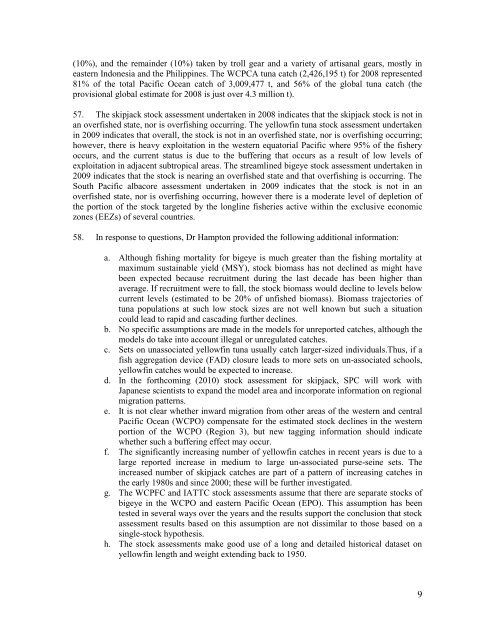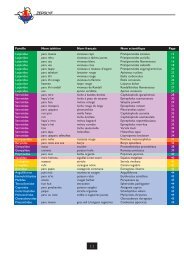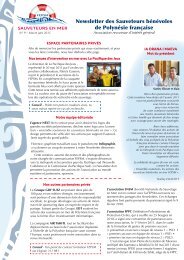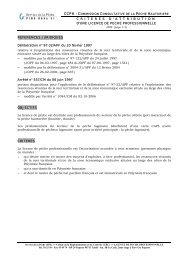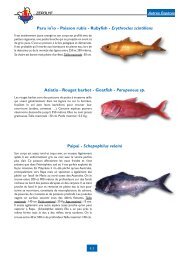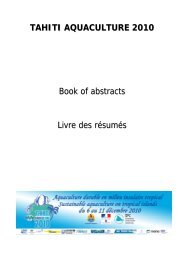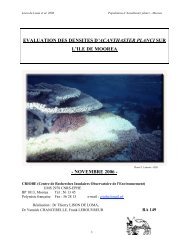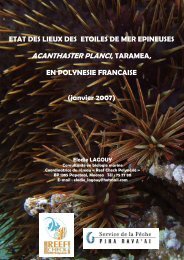Commission for the Conservation and ... - Site de la pêche
Commission for the Conservation and ... - Site de la pêche
Commission for the Conservation and ... - Site de la pêche
Create successful ePaper yourself
Turn your PDF publications into a flip-book with our unique Google optimized e-Paper software.
(10%), <strong>and</strong> <strong>the</strong> remain<strong>de</strong>r (10%) taken by troll gear <strong>and</strong> a variety of artisanal gears, mostly in<br />
eastern Indonesia <strong>and</strong> <strong>the</strong> Philippines. The WCPCA tuna catch (2,426,195 t) <strong>for</strong> 2008 represented<br />
81% of <strong>the</strong> total Pacific Ocean catch of 3,009,477 t, <strong>and</strong> 56% of <strong>the</strong> global tuna catch (<strong>the</strong><br />
provisional global estimate <strong>for</strong> 2008 is just over 4.3 million t).<br />
57. The skipjack stock assessment un<strong>de</strong>rtaken in 2008 indicates that <strong>the</strong> skipjack stock is not in<br />
an overfished state, nor is overfishing occurring. The yellowfin tuna stock assessment un<strong>de</strong>rtaken<br />
in 2009 indicates that overall, <strong>the</strong> stock is not in an overfished state, nor is overfishing occurring;<br />
however, <strong>the</strong>re is heavy exploitation in <strong>the</strong> western equatorial Pacific where 95% of <strong>the</strong> fishery<br />
occurs, <strong>and</strong> <strong>the</strong> current status is due to <strong>the</strong> buffering that occurs as a result of low levels of<br />
exploitation in adjacent subtropical areas. The streamlined bigeye stock assessment un<strong>de</strong>rtaken in<br />
2009 indicates that <strong>the</strong> stock is nearing an overfished state <strong>and</strong> that overfishing is occurring. The<br />
South Pacific albacore assessment un<strong>de</strong>rtaken in 2009 indicates that <strong>the</strong> stock is not in an<br />
overfished state, nor is overfishing occurring, however <strong>the</strong>re is a mo<strong>de</strong>rate level of <strong>de</strong>pletion of<br />
<strong>the</strong> portion of <strong>the</strong> stock targeted by <strong>the</strong> longline fisheries active within <strong>the</strong> exclusive economic<br />
zones (EEZs) of several countries.<br />
58. In response to questions, Dr Hampton provi<strong>de</strong>d <strong>the</strong> following additional in<strong>for</strong>mation:<br />
a. Although fishing mortality <strong>for</strong> bigeye is much greater than <strong>the</strong> fishing mortality at<br />
maximum sustainable yield (MSY), stock biomass has not <strong>de</strong>clined as might have<br />
been expected because recruitment during <strong>the</strong> <strong>la</strong>st <strong>de</strong>ca<strong>de</strong> has been higher than<br />
average. If recruitment were to fall, <strong>the</strong> stock biomass would <strong>de</strong>cline to levels below<br />
current levels (estimated to be 20% of unfished biomass). Biomass trajectories of<br />
tuna popu<strong>la</strong>tions at such low stock sizes are not well known but such a situation<br />
could lead to rapid <strong>and</strong> cascading fur<strong>the</strong>r <strong>de</strong>clines.<br />
b. No specific assumptions are ma<strong>de</strong> in <strong>the</strong> mo<strong>de</strong>ls <strong>for</strong> unreported catches, although <strong>the</strong><br />
mo<strong>de</strong>ls do take into account illegal or unregu<strong>la</strong>ted catches.<br />
c. Sets on unassociated yellowfin tuna usually catch <strong>la</strong>rger-sized individuals.Thus, if a<br />
fish aggregation <strong>de</strong>vice (FAD) closure leads to more sets on un-associated schools,<br />
yellowfin catches would be expected to increase.<br />
d. In <strong>the</strong> <strong>for</strong>thcoming (2010) stock assessment <strong>for</strong> skipjack, SPC will work with<br />
Japanese scientists to exp<strong>and</strong> <strong>the</strong> mo<strong>de</strong>l area <strong>and</strong> incorporate in<strong>for</strong>mation on regional<br />
migration patterns.<br />
e. It is not clear whe<strong>the</strong>r inward migration from o<strong>the</strong>r areas of <strong>the</strong> western <strong>and</strong> central<br />
Pacific Ocean (WCPO) compensate <strong>for</strong> <strong>the</strong> estimated stock <strong>de</strong>clines in <strong>the</strong> western<br />
portion of <strong>the</strong> WCPO (Region 3), but new tagging in<strong>for</strong>mation should indicate<br />
whe<strong>the</strong>r such a buffering effect may occur.<br />
f. The significantly increasing number of yellowfin catches in recent years is due to a<br />
<strong>la</strong>rge reported increase in medium to <strong>la</strong>rge un-associated purse-seine sets. The<br />
increased number of skipjack catches are part of a pattern of increasing catches in<br />
<strong>the</strong> early 1980s <strong>and</strong> since 2000; <strong>the</strong>se will be fur<strong>the</strong>r investigated.<br />
g. The WCPFC <strong>and</strong> IATTC stock assessments assume that <strong>the</strong>re are separate stocks of<br />
bigeye in <strong>the</strong> WCPO <strong>and</strong> eastern Pacific Ocean (EPO). This assumption has been<br />
tested in several ways over <strong>the</strong> years <strong>and</strong> <strong>the</strong> results support <strong>the</strong> conclusion that stock<br />
assessment results based on this assumption are not dissimi<strong>la</strong>r to those based on a<br />
single-stock hypo<strong>the</strong>sis.<br />
h. The stock assessments make good use of a long <strong>and</strong> <strong>de</strong>tailed historical dataset on<br />
yellowfin length <strong>and</strong> weight extending back to 1950.<br />
9


